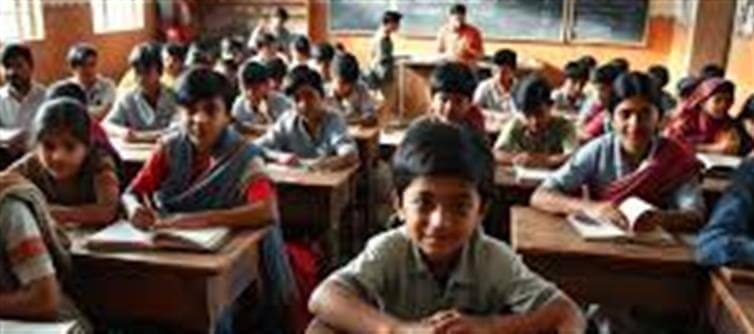
In a significant shift, Delhi's government schools are set to introduce the Rashtriya Swayamsevak Sangh (RSS) as part of their educational curriculum. Along with RSS, influential figures such as Veer Savarkar and Subhash Chandra Bose will now be included in history lessons, marking a change in how indian freedom struggles and socio-political movements are presented to students.
Here's everything you need to know about this major update in Delhi's school curriculum:
1. RSS to Be Taught as a Social and Cultural Organization
The Rashtriya Swayamsevak Sangh (RSS), one of India's largest and most influential socio-cultural organizations, will now be covered in school textbooks. The government aims to provide students with an understanding of the organization's origins, objectives, and its role in shaping indian society.
· Key Details: The inclusion of RSS will focus on its contributions to India's cultural identity, nationalism, and social service work, giving students an insight into its influence on contemporary politics and civil society.
2. Veer Savarkar's Contribution to the Freedom Struggle
Veer Savarkar, a controversial yet significant figure in India's freedom movement, is also set to be highlighted. Known for his writings and his role in the indian independence movement, Savarkar's ideas on nationalism and his role in the freedom struggle will be part of the updated curriculum.
· Key Details: students will learn about his book "The history of the First war of indian Independence, 1857," his contributions to the freedom movement, and his views on Hindutva.
3. subhash chandra Bose's Role in India's Independence
Subhash Chandra Bose, a beloved and pivotal figure in India’s fight for independence, will continue to be taught but with an enhanced focus. His leadership of the Indian National army (INA), his alliance with Japan, and his relentless pursuit of complete independence for india will be underscored.
· Key Details: The curriculum will explore his significant role in mobilizing resistance against british rule, his radical approach to independence, and his vision of a free India.
4. Curriculum Shift to Reflect Nationalist Ideals
The inclusion of these figures is expected to reshape how the country's national history and freedom movement are taught. The focus will likely shift toward more nationalist perspectives, with a heavier emphasis on the role of Hindu leaders and their contributions to India's struggle for freedom.
· Key Details: The curriculum aims to present students with a balanced view of the political and social figures that shaped India’s independence narrative, reflecting a nationalist standpoint.
5. Controversy and Debate: Will This Be a Polarizing Move?
This move has sparked both support and criticism. Proponents argue that teaching about these figures provides a well-rounded view of India’s history and nationalism. Critics, however, caution that focusing too much on RSS and Veer Savarkar, who have controversial legacies, may polarize students and promote a narrow view of India's freedom struggle.
· Key Details: Critics are concerned that the curriculum could potentially leave out alternative voices or the more inclusive aspects of India's diverse freedom movement.
6. Focus on Nationalism and indian Identity
The introduction of these topics reflects a strong emphasis on Indian nationalism, cultural pride, and the role of identity politics in shaping the future of the country. By including figures who were deeply involved in the shaping of India's identity post-colonization, the government seems to want to instill a sense of pride among students about India's heritage.
· Key Details: The move signals the current political climate’s influence on education, where the teaching of history is often shaped by present-day ideologies.
7. What This Means for the Future of education in Delhi
The integration of RSS, Veer Savarkar, and Subhash chandra bose into Delhi's educational curriculum will likely serve as a template for other states considering similar educational reforms. This change emphasizes the growing importance of cultural education and nationalistic narratives in schools.
· Key Details: This marks a pivotal moment in the evolution of India’s educational system, with implications for how future generations view India’s past, its leaders, and the country’s socio-political landscape.
Conclusion: A Bold New Chapter in Delhi's Curriculum
With the introduction of RSS, Veer Savarkar, and Subhash Chandra Bose in the school syllabus, delhi is setting a new precedent in shaping how future generations learn about India's history, politics, and culture. While this change aligns with the current political and cultural climate, it raises important questions about the future of history education in India. Whether this shift proves to be beneficial or polarizing will unfold in the coming years, but for now, Delhi’s schools are stepping into a bold new era of education.
Disclaimer:
The views and opinions expressed in this article are those of the author and do not necessarily reflect the official policy or position of any agency, organization, employer, or company. All information provided is for general informational purposes only. While every effort has been made to ensure accuracy, we make no representations or warranties of any kind, express or implied, about the completeness, reliability, or suitability of the information contained herein. Readers are advised to verify facts and seek professional advice where necessary. Any reliance placed on such information is strictly at the reader’s own risk..jpg)




 click and follow Indiaherald WhatsApp channel
click and follow Indiaherald WhatsApp channel